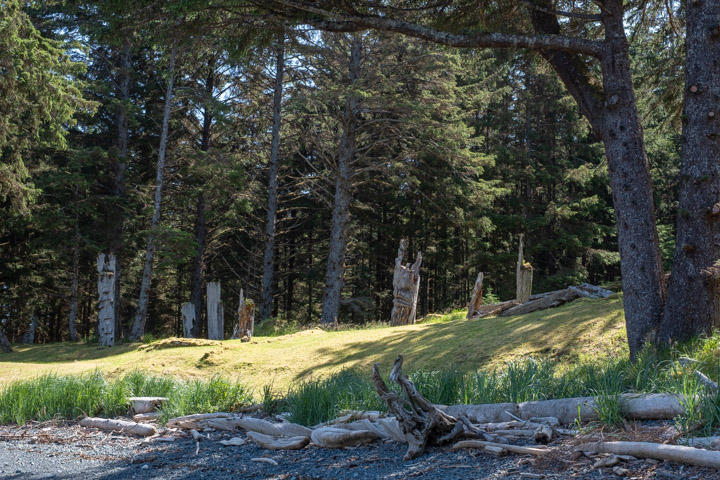
Photographing Haida Gwaii

The photographic landscape is shifting under us. I took four lenses to Haida Gwaii, assuming you count the Pixel 2 as one of them, and you should; that’s the landscape shift. The “real” lenses:
Fujifilm 35mm F1.4, my favorite lens I’ve ever owned. Also one of Fuji’s cheapest; goes to show something or other.
Fufifilm 55-200mm F3.5-4.8. Super-useful zoom range, could be faster, but then it’d be heavier.
Samyang 135mm F/2.0, which I’ve blogged about a lot here; a difficult, beautiful, opinionated tool.
Let’s start with a case study; some old weathered Haida totems on the beach at SG̱ang Gwaay, an astonishing place that deserves its own write-up. Here’s the 35mm version from back a bit:
Fuji X-T2, XF35mmF1.4R, 1/90 sec at f/8, ISO 200
I thought the grouchy totem at the right was the most interesting, and realized this was the kind of situation the Samyang was made for, and shot again.
Samyang 135F2, 1/300 sec at unknown aperture, ISO 200
From this we learn that the 35mm is wonderful at replicating what you saw during that moment when you were thinking “Wow, that’s beautiful’, and a long lens is just the ticket for composing detail shots at a distance.
But… · The problem is logistics. The Samyang is great when I go out for a nice leisurely walk looking for dramatic bokeh-laden detail shots. But when you’re switching from bouncy Zodiac to soft beach sand to scrambling over drift-logs to forest floor, carrying multiple lenses along and changing them really sucks, and so a wide-ish range zoom is just the ticket. Next time I do something like this I won’t take the Samyang.
But to its credit, it did a fab job on this Haida Watchman fire, which was producing some of the nicest-smelling smoke I’ve encountered.
Fuji X-T2, Samyang 135F2, 1/900 sec at unknown aperture, ISO 200
But in terms of outperforming expectations… Wow, that Pixel. Let me show off a bit.
Pixel 2, 1/400 sec at f/1.8, ISO 51; 1/1250 sec at f/1.8, ISO 56; 1/120 sec at f/1.8, ISO 52; 1/320 sec at f/1.8, ISO 50
Don’t know about you, but I think the capture of detail and color is awesome. And unless you’re doing professional magazine or display work, here’s a news flash: You don’t need a wide-angle lens any more on your “real” camera.
Here’s another nice Pixel pic, and then the results of pointing the long lens at the same scene.
Above: Pixel 2, 1/1150 sec at f/1.8, ISO 60; Below: Fuji X-T2, XF55-200mmF3.5-4.8, 55mm, 1/250 sec at f/3.5, ISO 200
In the boat, I kept my waterproof knapsack by my side with the Fuji, 55-200mm strapped on, near the top. I could get it out and shoot fast, and there was really no other reasonable lens choice. I always had the Pixel in my vest pocket; just had to undo a couple of layers of waterproof and I could have it ready almost as fast.
But that sweet little beat-up old 35mm remains my heart-throb. Point it at something interesting and it’ll almost never be the limiting factor in the quality of what you get.
Fuji X-T2, XF35mmF1.4R, 1/125 sec at f/8; 1/480 sec at f/8; 1/250 sec at F5.6. All ISO 200.
I was reasonably happy with the results. But there’s a problem: The diminutive Fujifilm body is just kind of klunky and awkward with a long lens attached, even a relatively svelte one like the 55-200mm. Now, everybody knows that We Must Suffer For Our Art and since we’re talking metal and glass here, there’s not much relief on the horizon. But my wrists and neck got camera-sore.
One other person in the party had a Nikon SLR with an all-purpose zoom strapped on. Another had one of the “tourist” cameras with a built-in massive-range zoom. And there were a few old-school point and shoots. It’s not obvious that any of the above were a worse choice than what I took.
Final note: Haida Gwaii is more often dim, grey, and wet than bright and sunny as in my photos. We got seriously lucky. I wonder if shooting wet and under clouds would change the equation any?